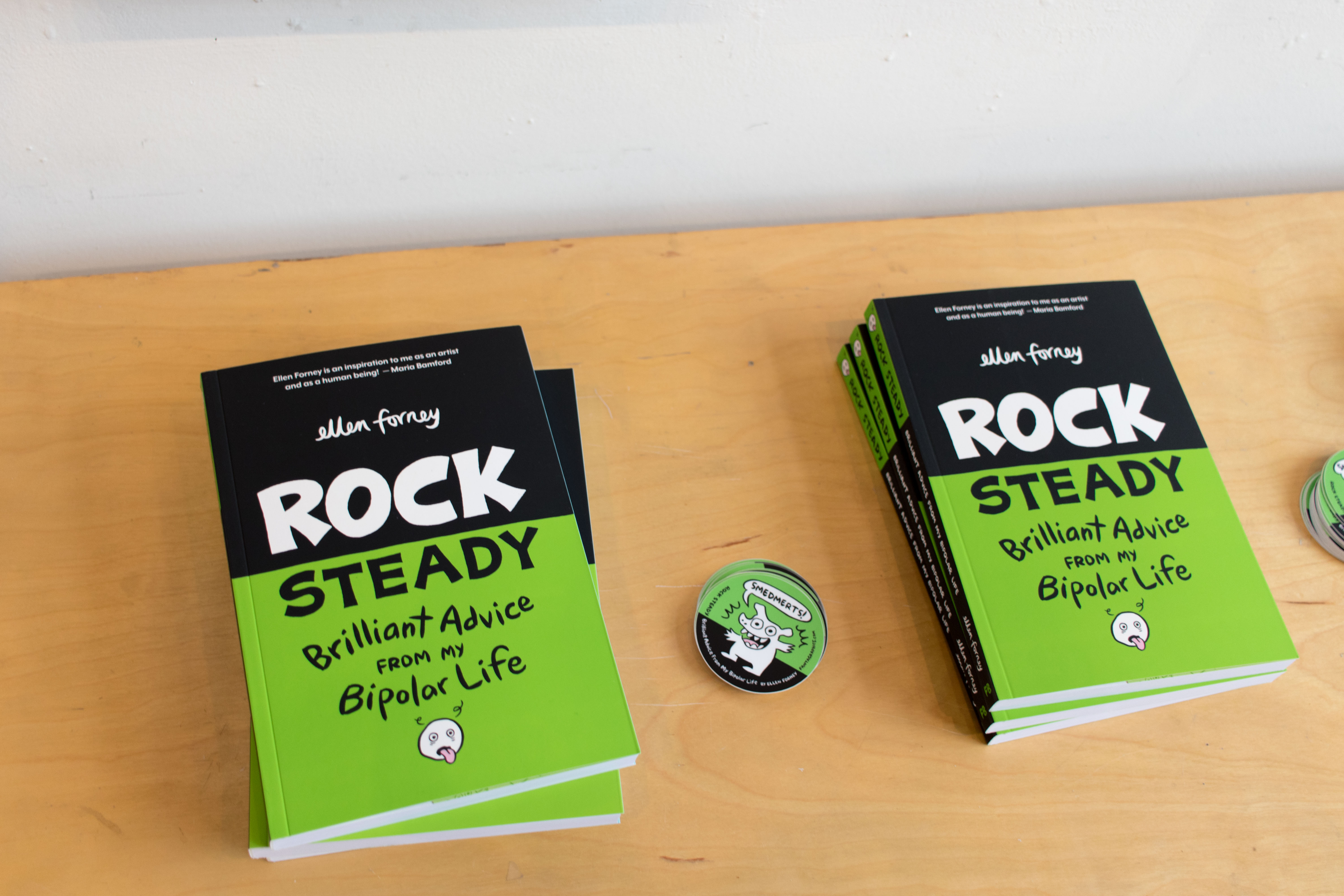
Ellen Forney on How to be “Rock Steady”
Written by Sepia Katsoolis, 05/08/2018
Ellen Forney, author of the one-of-a-kind graphic novels Marbles: Mania, Depression, Michelangelo and Me; Monkey Food (Eisner-nominated); I Love Led Zeppelin (Eisner-nominated) and Lust: Kinky Online Personal Ads. Forney, who wrote for decades for the Stranger, received The Stranger Genius Award in Literature in 2012 for her work. She releases her newest graphic novel Rock Steady: Brilliant Advice from My Bipolar Life on May 15, click here to order it now.
Rock Steady is a highly anticipated follow up to Marbles, Forney’s memoir on her bipolar disorder. It provides a range of tools to equip any human being, or those diagnosed with Bipolar disorder, to live a more emotionally stable life.
Her art constantly inspires me in so many ways from seeing her mural at the light rail station on my way to class at SCC, to getting compliments when I’m wearing my favorite sweater that is a one-of-a-kind created with one of her original art designs for the light rail mural, to reading her books that focus on sexuality and mental health issues often left untouched.
Forney has mastered vulnerability through her art as well as addressed often complex or tedious issues in a very digestible way.
On May 5, 2018 Forney’s Rock Steady tour began at Fantagraphics Books. The store was crowded for Free Comic Book Day. Forney wore lime green nail polish, the color of mental health awareness and the cover Rock Steady, in honor of May being Mental Health Awareness Month. After signing many copies of her new book, Forney sat down with me for an interview, which is included below.
The following interview has been edited for clarity and length.
Sepia Katsoolis: My first question is: with all of your different styles of art how did you go from point A to point B?
Ellen Forney: One constant really, is that I use a brush. One of the things that my students pressure themselves about and what I used to think about it is “What is my style?” and I think that once you let go of that, then it just comes. And my impression of my work is that I use a lot of different styles. But at the same time, they are a part of a whole. People tell me that they can tell when it’s mine. That they could tell the light rail mural was mine even when it’s really quite different from my comics.
To me, it is a certain sensibility. It’s also something more abstract like my involvement and my passion for my work. There’s the brush and what the brush looks like, what the brush does, and doesn’t do, and the certain spare quality. Subject matter. There’s a lot of consistency that comes out in my work, like what my interests are. What I’m interesting in exploring. Then there are the styles, there’s a lot in common, and a lot quite different, depending on the context. So I think as a storyteller, one of the things that is a tool for me, in communicating tone, and subject, is how it is presented visually. Is it something that is really serious that needs to be funny? Is it something that I want my reader to spend more time on and figure out or do I want it to read really simply? For the most part my work is really spare and pretty iconic. As a cartoonist, when I’m doing something as a narrative, I use that as a tool, but when I’m doing something heavier on the visual aspect, like for the light rail station, a lot of the decisions I make depend on the context and meaning.
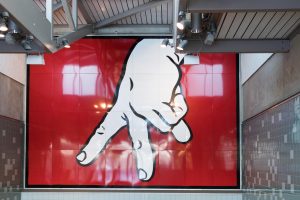
Capitol hill light rail mural, art by Forney.
SK: Once you realized you were stable, how did you deal with thoughts or feelings that you might slip back into cycling?
EF: It’s always a possibility, because there is no cure, for me it was learning to take care of myself because I don’t wanna cycle. It became a big part of my life –stabilizing. And that’s where a lot of the material in Rock Steady came from. In that, it takes a lot of effort, it takes a lot of thought, and ideally it’s folded into what you do. For me, sleep is a priority. It’s not an option for me to go to a party at 2 am, but I don’t wrestle with that anymore. That’s what this acronym SMEDMERTS is.
SK: What does SMEDMERTS stand for?
EF: Sleep, Medication (if you take meds, take your meds), Eat well, Doctor, Meditation/Mindfulness, Exercise, Routine, Tools for coping, Solid Support System.
All of those things need to come into play, somethings more than others, and some things can go in and out. I didn’t start meditating until 4 years ago but that really snapped things all together. I’m going to be going out on tour, I’ll be dealing with jet lag, excitement, and setting off my routine on purpose, and it’s a matter of compensating for those things.
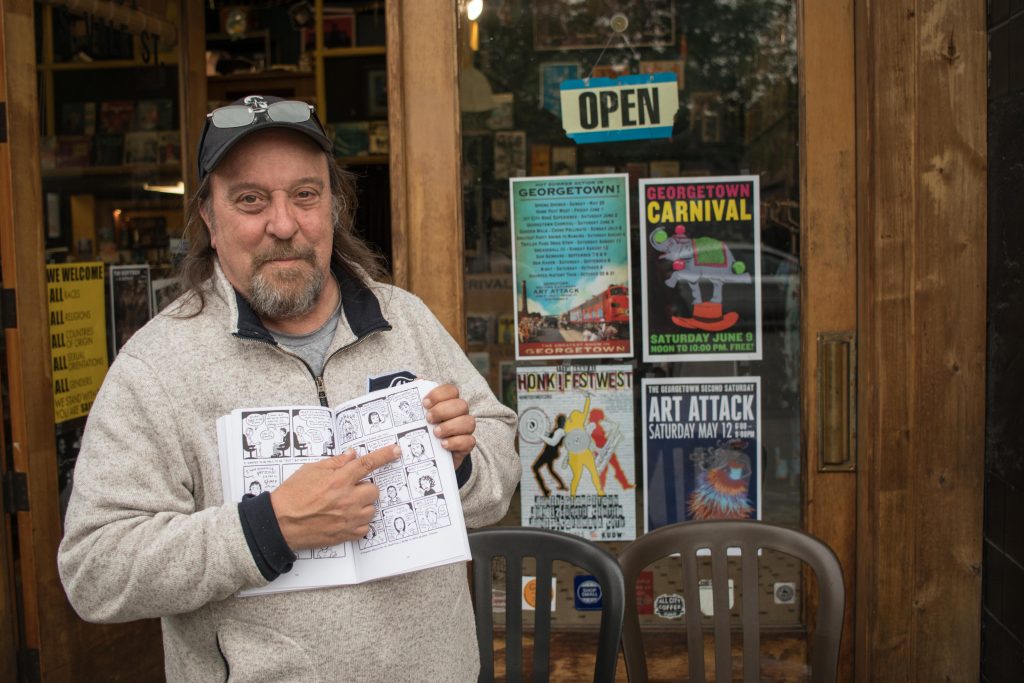
Larry from Fantagraphics comic shop and a friend of Forney, points to his cameo in Marbles.
SK: What were some of the things that you thought were the most impossible, that you have now accomplished?
EF: The first thing that came to mind, is that one thing that has been so awesome about sticking to what I do and working really hard is getting to meet heroes and getting to know people that I really admire, and not just as a fan, but as also someone who has my own work and self to offer as something interesting. Like Alison Bechtel was a really big influence on me, since way back, she was one of the reasons I decided to be a professional cartoonist. Meeting her, and getting to be acquaintances and then friends. Like I have her phone number in my cell phone kind of thing. I never would have expected that. I never thought that, that would be where I would be. So just meeting your heroes and having something to offer.
My career path has mostly been kind of organic. I never thought that I would focus on mental health. I was going to be all activist. And then I put out Marbles. In my earlier work all of my work was about being queer and sex positive and having an alternative lifestyle. That’s what I thought all of my work was going to deal with. Marbles is all of those things, like queer, looking at accepting ourselves and other people, and compassion and understanding, but it has become so much more centered around mental health and mental illness. I didn’t think that I was going to do a second book about mental health. It’s just become a big part of what I am known for and what I do. I like it, it makes me feel really purposeful. I really didn’t know that this was going to be where I land, at least for now. But it feels so worthwhile.

“I LOVE LED ZEPPELIN” poster from Forney’s book of the same name hanging in Fantagraphics comic shop.
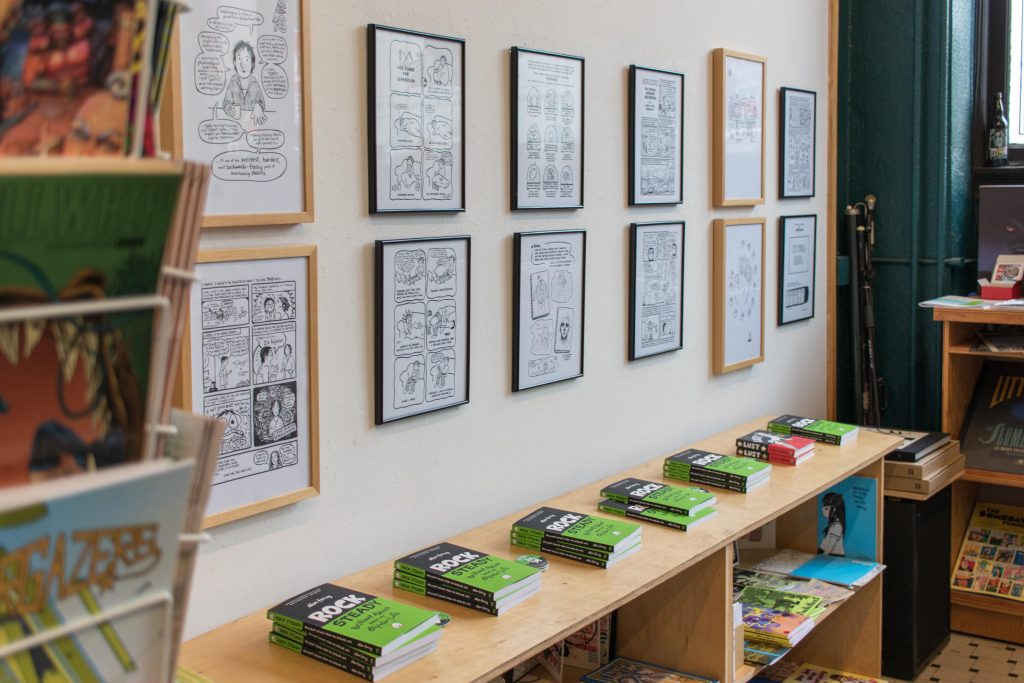
Stacks of Rock Steady at the book signing in Fantagraphics comic shop.
SK: You mention doodling in reporters notebooks in Marbles, is that your favorite kind of notebook to write in? And have you kept all of your notebooks throughout your life?
EF: I keep a few different notebooks I guess. I started keeping journals, the lined paper, regular, spiral bound notebooks. Not right when I was diagnosed, but probably a couple years later, and yeah I kept all of those. Marbles would have been very different if I hadn’t kept all of those. For one I wouldn’t have had the drawings. I don’t think I would have been able to reconstruct that. I keep a small journal by my bed, always. I’m not one of those artists that keeps a sketchbook with me all of the time, I kind of wish I were and I always admired that but I don’t.
SK: The way it seems to me, is that you have reached a sort of comfort in your life, and I am curious as to how you deal with uncertainty? And is there any way that being bipolar has affected the way you think about uncertainty?
EF: The first thing that comes to mind with that, is that a lot of liberals of my ilk have been kind of thrown into a kind of strange mindset with the current administration. And have a lot of uncertainty and really struggle with how to figure out how to stay grounded and focused. At the end of 2016 (when the election happened) I was at a writers residency in New Hampshire called the MacDowell Colony, so we were all away from our homes and our support systems. It was really strange and surreal and odd, it was beautiful there, but it was like we were all in a bizarre bubble. But I printed out a copy of a page from Marbles of the alternate nostril breathing and a copy of it in everybody’s little mailbox. And a lot of people came up to me later and thanked me, they had been doing that exercise and that they had found it really helpful. That might seem like one little tool of many, but if it works, it’s huge! So I guess living with uncertainty is hard, everybody does, the only constant is change, and change is hard for every human. That’s something we talk about in yoga.
SK: And SMEDMERTS!
EF: Exactly, and for me meditation has become a huge part of that.
SK: Could you tell me more about the incredible back tattoo of yours from the first chapter in Marbles?
EF: So it was Seattle in the mid/late 90’s, tattoos had a place where it was a little more uncommon and I just really loved them. I had thought about if I wanted one or not. It was one of those things where it really was a manic– not revelation really, but one of the characteristics with mania is that you make a lot of associations that you might not expect, or that are unusual or “how did you think of that?” or “how did you put those things together?”
So for me it really brought things together that I don’t know if I could really say what the entire path was. I know for one, and I say this in Marbles, how I really hated my back. I had that deep cystic acne in my back and it was scarred and I just thought that it was really ugly. Of course I couldn’t see it, and say oh that isn’t actually that bad, but to me it was just horrible. And my dedication to comics was a new thing, I was like, okay, this is the thing that I’m going to be doing. Then always feeling my connection to water, with being a swimmer and being out here in the Pacific Northwest, and all of those things. I don’t know how it all really collided, this explosion that all of those things could come together into one. It was also that it would cover my whole back; how ballsy is that? Right?
When I asked Kaz, the cartoonist, and he agreed to do it, I was in New York, and he traced my back and I remember being in a cab on the way to a club to go dancing and he asked me how many tattoos I had, and I said, “No, this is my first and it’s going to be my only one.” He was like, “WHAT?!” And that’s why he said it was the hardest illustration job he had ever done. There’s also that I asked him to revise things a couple times. I have the original art and that hangs in my studio. I used to have the artwork above my couch, the couch in Marbles. I would lie there and kind of trace the swirls and characters with my eyes. So it’s really funny when I look at the mirror at my back because it’s so familiar, but I hardly ever see it.
Thanks Ellen, Rock Steady!
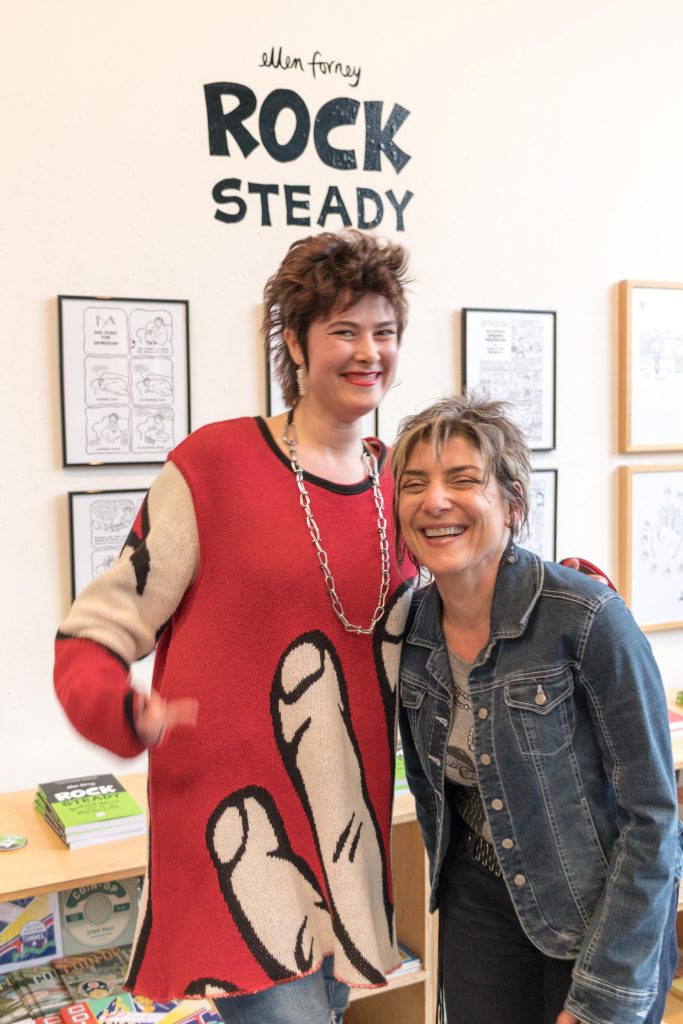
Forney and myself (wearing a sweater with her design) at “Rock Steady” book signing. Photo thanks to Jake!


